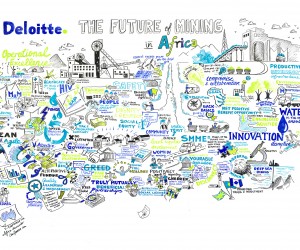Inclusive growth: The future of sustainable mining in Africa
A key outcome from this year’s Mining Indaba is that, for the sector to remain sustainable, the concept of inclusive growth needs to be adopted by all industry players.
A theme touched on by Minster of Mineral Resources, Mosebenzi Zwane, in his opening address earlier this week, delegates reiterated that the concept of shared value is now more relevant than ever.
This idea, amongst others, was captured by a graphic artist as part of a visual Deloitte demonstration throughout the week at the event. Delegates were asked what they believed was the answer to a sustainable mining future, and the answers were drawn live on a white board in front of passers by, culminating into a collaborative roadmap for the future of the African mining landscape.
“The concept of growing and working together as labour, industry and government is absolutely key to the future and development of the mining industry,” says Andrew Lane,Africa Mining Leader at Deloitte.
Some of the highlights (and challenges facing Africa) that were visually captured include:
Social equity: In recognising that people are its most vital asset, the mining industry has to work collectively at inculcating greater dignity and respect among its workforce and community relations if it desires sustainable returns. Safety, training, community development and youth education are important.
Social license to operate: In Africa, mining operations must involve a mutually beneficial relationship that offers something for adjacent communities, creating a mine’s social license to operate. This demands shared goals, compromise and collaboration, thereby creating a net-positive benefit.
Local supplier development: Community development and sustainable mining operations should see miners support local businesses through their Enterprise Development and Procurement initiatives. Other initiatives could include widening the participation of women in mining operations and ancillary activities, as well as training and education of community members so as to eradicate the disconnect that they may see between their lives and local mining operations.
A new investment model: For a sustainable operation, mines could consider impact investors, whose investment strategies focus on social responsibility.
Mines of the future will have to dovetail with other initiatives, such as:New infrastructure systems that benefit entire communities, not just the mines.
A balanced portfolio in energy, consisting of a mix of carbon-based and renewable energy sources.
Sustainability footprint: When mines are eventually closed they can be turned into engineered aquifers, providing potable water for the local communities.
Back to Basics: In a tight economic environment with low commodity prices, one cannot neglect the customary business practices of Back to Basics, doing things quicker and better.
Technology and skills: The future mining organisation will be lean and agile, embracing Big Data and the Internet of Things; balancing technology with the retooling and upskilling of personnel for this new age of mining. Drones, wearable tech and other smart systems could aid in creating a sustainable mining organisation.
• Good governance: Investment will only be attracted to regions where good governance exists: No corruption or greed (either political or corporate); policy certainty, particularly tax and regulatory certainty; and red tape, will have to be kept to a minimum.
“Given the current climate in the mining sector, we need ensure that the scales are balanced so that everybody wins. As such, inclusive growth may just be the potential blueprint for sustainable mining in Africa,” concludes Lane.






